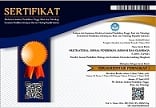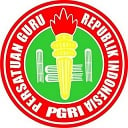Indonesia Student Fitness: A Quantittive Descriptive Study SDN 5 Sungai Ulin, Banjarbaru
Abstract
This study aims to describe the physical fitness levels of students at SDN 5 Sungai Ulin based on the results of the TKSI Stage B test, evaluated by individual test items. A descriptive quantitative approach was used in this research. The study was conducted at the elementary school field of SDN 5 Sungai Ulin, Banjarbaru. The subjects were third and fourth-grade students, consisting of 104 students (52 males and 52 females) aged 8-10 years during the 2024/2025 academic year. The survey method was employed, with data collected through the Indonesian Student Fitness Test (TKSI). The Stage B TKSI results include five main assessment items: V Sit and Reach Test, Half Up Test, Hand-Eye Coordination Test, T-test, and Around the World Test. These five fitness tests provide a comprehensive picture of various physical fitness aspects, including flexibility, abdominal strength, hand-eye coordination, agility, and cardiovascular endurance. In general, most students fall within the "Moderate" to "Poor" categories. Flexibility and hand-eye coordination showed relatively good results, particularly among female students. However, agility and aerobic endurance require significant improvement, with most students categorized as "Poor".
Keywords
Full Text:
PDFReferences
Badicu, G., Silva, A. F., Miguel, H., & Sarmento, B. (2023). Monitoring and Promoting Physical Activity, Physical Fitness and Motor Competence in Children. In Monitoring and Promoting Physical Activity, Physical Fitness and Motor Competence in Children. https://doi.org/10.3390/books978-3-0365-6650-4
Baltaci, G., Un, N., Tunay, V., Besler, A., & Gerçeker, S. (2015). Comparison of Three Different Sit and Reach Tests for Measurement of Hamstring Flexibility in Female University Students. British Journal of Sports Medicine, 37(1), 59-61. https://doi.org/10.1136/bjsm.37.1.59
Du, S., Hu, H., Cheng, K., & Li, H. (2023). Exercise Makes Better Mind: A Data Mining Study on Effect of Physical Activity on Academic Achievement of College Students. Frontiers in Psychology, 14(October), 1-10. https://doi.org/10.3389/fpsyg.2023.1271431
Gajardo-Araya, G., Hernández-Jaña, S., Olivares-Arancibia, J., Ferrari, G., Delgado-Floody, P., & Cristi-Montero, C. (2022). Physical Fitness Mediates the Inverse Association between Fatness Indicators and Academic Achievement, Despite the School Vulnerability of Adolescents—The Cogni-Action Project. Frontiers in Nutrition, 9(October), 1-12. https://doi.org/10.3389/fnut.2022.904831
Green, C., Mynhier, L., Banfill, J., Edwards, P., Kim, J., & Desjardins, R. (2020). Preparing Education for the Crises of Tomorrow: A Framework for Adaptability. International Review of Education, 66(5-6), 857-879. https://doi.org/10.1007/s11159-020-09878-3
Hanvoravongchai, J., Laochindawat, M., Supapong, S., & Ratanachina, J. (2024). Association of Physical Fitness with the Work Ability of Aging Workers with Physically Demanding Jobs in a University Hospital in Thailand. Safety and Health at Work. https://doi.org/10.1016/j.shaw.2024.06.003
Irmawan, R., Habibi, A. I., & Irmawati, F. (2022). Physical Fitness Level Survey in Grade VIII Students of PGRI Bangil Junior High School. Prosiding Seminar Nasional Pendidikan Jasmani dan Keolahragaan, 255-261. https://doi.org/10.33503/prosiding_penjas_pjkribu.v1i1.2337
Pusmendik. (2021). Instrumen Asesmen Kebugaran Siswa Indonesia. https://kebugaran-pusmendik.kemdikbud.go.id/
Mashud, Arifin, S., Warni, H., Samodra, Y Touvan, J., Yosika, G. F., Basuki, S., Suryadi, D., & Suyudi, I. (2024). Physical Fitness: Effects of active lifestyle internalization through physical literacy awarenes based project. Retos: Nuevas Tendencias En Educación Física, Deporte y Recreación, 52, 1299-1308. https://dor.org/10.47197/retos.v51.101662
Nowreen, N., Bashir, M., Sofi, I. A., & Sayeed, S. I. (2023). Physical Fitness and its Association with Anthropometric Parameters in Medical Students. Asian Journal of Medical Sciences, 14(7), 229-233. https://doi.org/10.3126/ajms.v14i7.53699
Redondo-Flórez, L., Ramos-Campo, D. J., & Clemente-Suárez, V. J. (2022). Relationship between Physical Fitness and Academic Performance in University Students. International Journal of Environmental Research and Public Health, 19(14750). https://doi.org/10.3390/ijerph192214750
Redondo-Gutiérrez, L., Afonso, R. C., Molina, A., Sanchez-Lastra, M. A., & Ayán, C. (2022). Associations between Self-Perceived and Desired Health-Related Physical Fitness in Spanish Children. Children, 9(9), 1-9. https://doi.org/10.3390/children9091314
Reynolds, A. J., Ou, S. R., Eales, L., Mondi, C. F., & Giovanelli, A. (2021). Assessment of a Comprehensive Early Childhood Education Program and Cardiovascular Disease Risk in Midlife. JAMA Network Open, 4(8), 1-11. https://doi.org/10.1001/jamanetworkopen.2021.20752
Risaldi, M. Y. D., Reo Prasetiyo Herpandika, & Pratama, B. A. (2023). Penerapan Tes Kebugaran Siswa Indonesia (TKSI) di SDN Siwalan 1 Kabupaten Nganjuk. SPRINTER: Jurnal Ilmu Olahraga, 4(2), 224-232. https://doi.org/10.46838/spr.v4i2.358
Nugroho, R. A., Febrianti, R., & Hakim, A. R. (2022). Survei Tingkat Kebugaran Jasmani Siswa Kelas IV, V dan VI SD Negeri 02 Celep Kecamatan Nguter Kabupaten Sukoharjo Tahun 2022. Jurnal Ilmiah Penjas (Penelitian, Pendidikan dan Pengajaran), 8(2), 72-83. https://doi.org/10.36728/jip.v8i2.2063
Shavkidinova, D., Suyunova, F., & Kholdarova, J. (2023). Education Is an Important Factor in Human and Country Development. Current Research Journal of Pedagogics, 04(01), 27-34. https://doi.org/10.37547/pedagogics-crjp-04-01-04
Suárez-Cano, L., Bernal-Ballén, A., & Briceño-Martínez, J. J. (2023). A Multivariate Study for Determining the Relationship Between Physical Activity, Physical Fitness, and Academic Performance Estudio. Sportis, 9(2), 284-301. https://doi.org/10.17979/sportis.2023.9.2.9520
Warni, H., Arifin, S., & Sulaiman. (2019). Analisis Tingkat Kesegaran Jasmani Peserta Didik Lingkungan Lahan Basah pada Sekolah Dasar Negeri Bunipah 2 di Kecamatan Aluh-Aluh. Multilateral Jurnal Pendidikan Jasmani dan Olahraga, 18(1), 19-24. https://doi.org/10.20527/multilateral.v18i1.6563
Yaroshevich, I. N. (2023). Increasing the Level of Physical Fitness Students. Современные Технологии и Научно-Технический Прогресс. https://doi.org/10.36629/2686-9896-2023-1-370-371
Zainudin, N. I., Athar, & Kahri, M. (2019). Analysis ofthe Fitness Components of Private Vocational School Students Viewing from Vocational School of Education and Infrastructure Education 10 - 12 Years of Banjarbaru City. Multilateral Jurnal Pendidikan Jasmani dan Olahraga, 18(1), 63-69. https://doi.org/10.20527/multilateral.v18i1.6570
Zenina, I., Gavrilova, N., Kuzmenko, N., & Kachalov, O. (2022). Factors That Ensure an Adequate Level of Physical Fitness in Female Students of Higher Education Institutions. Scientific Journal of National Pedagogical Dragomanov University. Series 15. Scientific and Pedagogical Problems of Physical Culture (Physical Culture and Sports), 12(12(158)), 36-39. https://doi.org/10.31392/npu-nc.series15.2022.12(158).09
Zhang, Y. (2022). An Empirical Study on the Influence of College Students’ Physical Fitness on the Level of Public Health. Journal of Environmental and Public Health, 2022. https://doi.org/10.1155/2022/8197903
DOI: http://dx.doi.org/10.20527/multilateral.v23i4.20878
Article Metrics
Abstract view : 38 timesPDF - 13 times
Refbacks
- There are currently no refbacks.
Copyright (c) 2024 Multilateral : Jurnal Pendidikan Jasmani dan Olahraga

This work is licensed under a Creative Commons Attribution-ShareAlike 4.0 International License.
Tools:
Indexed by:

Multilateral : Jurnal Pendidikan Jasmani dan Olahraga is licensed under a Creative Commons Attribution-ShareAlike 4.0 International License.

















